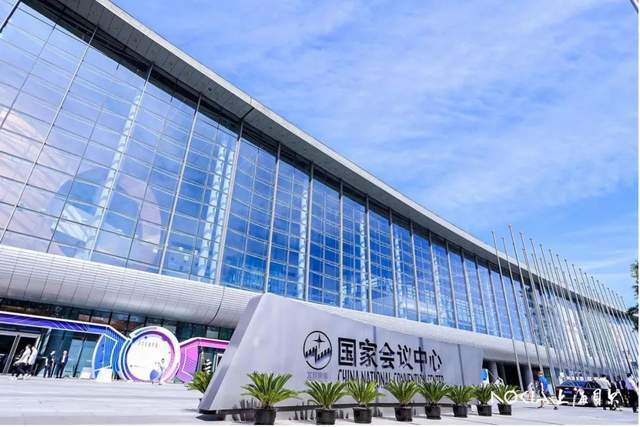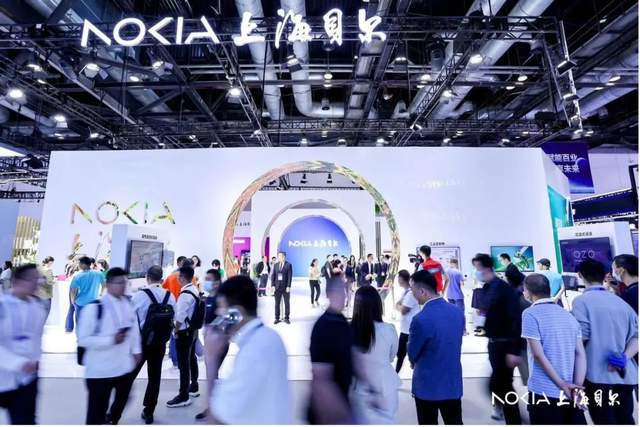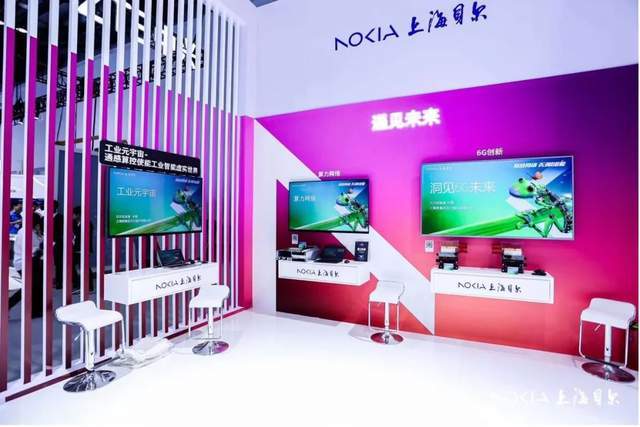 Technology peripherals
Technology peripherals
 AI
AI
 Nokia Bell's new runway: taking advantage of the industrial Internet of Things to promote the integration of data and reality
Nokia Bell's new runway: taking advantage of the industrial Internet of Things to promote the integration of data and reality
Nokia Bell's new runway: taking advantage of the industrial Internet of Things to promote the integration of data and reality
As one of the annual grand events of the domestic pan-ICT industry, the China International Information and Communications Exhibition has been held for the 31st time so far. Every year, at this important domestic industry exhibition, heavyweight manufacturers in the industry will release forward-looking trend reports, leading technologies and products, using cutting-edge insight capabilities to outline industry applications in the technology field for attendees in advance. blueprint.

Nokia Bell’s booth should be one of the well-deserved focuses at this year’s China International Information and Communications Exhibition. On the one hand, Nokia has undergone a brand refresh and upgrade this year, and its new image is also unveiled at this exhibition for the first time. From the LOGO to the visuals, it is refreshing; on the other hand, Nokia Bell has presented a cutting-edge industrial metaverse during the exhibition. , computing power network and 6G innovation and other important technology displays gave a valuable and important interpretation of the future evolution and development of ICT, attracting the attention of the audience.
It is worth mentioning that Nokia Bell also released the "2030 Technology Vision White Paper" and Nokia's latest version 4.0 "Know, Now" trend report on site. Through the on-site release, Nokia Bell conducted a forward-looking analysis and interpretation of technology, applications, and the relationship between humans and society from the perspective of a B2B technology innovation leader.

Industrial Internet of Things, computing power network and 6G innovation promote the integration of data and reality
The development of ICT technology is building a digital world. Nokia Bell innovatively proposed that the continuous development of network technology, cloud technology, computing technology, biotechnology, etc. is promoting the integration of the physical world and the digital world. Especially as the transformation of ICT technologies such as 5G/6G networks, cloud computing, chips and software, artificial intelligence and computing power, quantum computing and blockchain accelerates, their cross-integration and iteration will continue to generate new development needs for individuals, industries and society. , will have a profound impact on the breadth and depth of digital transformation.
Adhering to this application trend of digital and real integration, Nokia Bell's latest "2030 Technology Vision White Paper" released at the China International Information and Communications Exhibition proposed to continue to consolidate new digital base capabilities, through human-machine enhancement and twin reconstruction and other innovative capabilities to realize the path of virtual and real integration and the planning of immersive technology systems.
Technological innovation is Nokia Bell’s strength. Today, Nokia Bell has targeted the industrial manufacturing field to inject new technological vitality into the Industrial Internet of Things. In Nokia Bell's view, this is a track with great competitiveness and the possibility of innovative breakthroughs. At the same time, its success in the industrial Internet of Things has also enabled Nokia Bell to extend its innovation capabilities and successful experience through computing network and 6G innovation.

In terms of the Industrial Internet of Things, Nokia Bell Labs has defined the industrial metaverse enabling architecture and is able to demonstrate core supporting technologies such as communication, sensing, computing, intelligence, and control through the metaverse factory prototype, thereby expanding the potential of the network and through Innovation drives the industry to transform into the industrial metaverse era. The industrial metaverse builds a new paradigm of industrial systems with virtual and real symbiosis, interoperability, and intelligent and efficient closed-loop throughout the entire industrial life cycle.
In terms of computing power network, Nokia Bell adheres to the development strategy of evolution and innovation to promote the development of computing power network. For typical business scenarios, Nokia Bell can verify innovative solutions such as dynamic sensing of computing networks, joint orchestration and scheduling of computing networks, and computing network routing through prototypes. At the same time, Nokia Bell also innovatively proposed a computing network edge architecture to support ubiquitous virtual-real interaction in the future metaverse.
In terms of 6G innovation, it is revealed that the main research results of 6G sensing and 6G AI air interface come from the Nokia Bell Labs China team. Previously, Nokia Bell has successfully completed key technology tests such as 6G terahertz communication, synaesthesia integration and AI air interface organized by China's IMT-2030 (6G) Promotion Group, and achieved excellent results. Driven by Nokia, China's IMT-2030 (6G) Promotion Group and the European 6G-IA signed a memorandum of understanding to jointly promote the innovative development of 6G.
Human augmentation technology: technological development promotes the integration of data and reality
From the free use of water and fire, to the invention of airplanes, cars, and ships, to today's single-person aircraft and exoskeleton equipment, there is no doubt that human beings have made breakthroughs in their own abilities and explored the physical world. Never ending for millions of years. Today, using the development of ICT and digital informatization, human augmentation technology that truly changes human potential and improves reaction and decision-making capabilities is entering the fast lane of application. At the same time, this technology also represents an important development direction for digital-real integration.
In the trend report "Insight into the Present, Foresee the Future" released this time, Nokia Bell focuses on the current status and development trends of human augmentation technology, and explores its importance to enterprises and operators. The trend report identifies five major shifts that enterprises and operators should pay close attention to as human augmentation technologies bring about.

First of all, the development of AI has created a new trend of augmented applications. The extensive application and in-depth understanding of artificial intelligence have made possible solutions and human augmentation applications that were unimaginable a few years ago.
Second, the next generation network unlocks human opportunities. Agile, software-driven networks provide high-quality, private and secure communications, enabling enhanced technologies to connect and interact with the world and each other.
Third, edge data processing can transform human potential, and the flexibility of cloud processing can reduce data processing and round-trip times, facilitate the execution of data-intensive tasks, and accelerate the development of an augmented workforce.
Fourth, partnerships are the backbone of human enhancement. To meet the requirements for richer experiences and higher productivity, technology and expertise need to be integrated to fully realize digital potential.
Fifth, technological development will push customer expectations into a new stage. The evolution from 5G to 6G, as well as the continuous advancement of artificial intelligence and wearable technology, will greatly enhance the expectations of enterprises and consumers.
"Human augmentation and digital-physical world integration have always been Nokia's key technology research directions, which is also an important support for Nokia's 2030 technology vision." said Xu Jing, head of Nokia's Bell Marketing Department.
Ready to go, adhering to the infinite vision and planning for the physical world and the digital world. Today, Nokia has not only found its own new direction and new goals, but also made great strides in the industrial metaverse, 6G, and computing power networks. There is no shortage of leading teams in innovative applications and technologies. Overall, by integrating its own advantageous resources, fully linking up with partners, and restructuring technology and product application directions, Nokia Bell is allowing technological innovation to flow, be implemented, and generate value.
Domestically, with the continuous deepening of the construction of Digital China, digital-real integration has become an inevitable development direction for the implementation of ICT industry applications. As a B2B technology innovation leader, Nokia Bell has accurately positioned itself, relying on its positioning with both global vision and local experience, as well as innovative technologies and products, to put digital applications around each of us. This promotion of digital-real integration is Nokia Bell's responsibility to promote social and economic development, and is also an important manifestation of its foresight and execution capabilities.
The above is the detailed content of Nokia Bell's new runway: taking advantage of the industrial Internet of Things to promote the integration of data and reality. For more information, please follow other related articles on the PHP Chinese website!

Hot AI Tools

Undresser.AI Undress
AI-powered app for creating realistic nude photos

AI Clothes Remover
Online AI tool for removing clothes from photos.

Undress AI Tool
Undress images for free

Clothoff.io
AI clothes remover

AI Hentai Generator
Generate AI Hentai for free.

Hot Article

Hot Tools

Notepad++7.3.1
Easy-to-use and free code editor

SublimeText3 Chinese version
Chinese version, very easy to use

Zend Studio 13.0.1
Powerful PHP integrated development environment

Dreamweaver CS6
Visual web development tools

SublimeText3 Mac version
God-level code editing software (SublimeText3)

Hot Topics
 What are the roles of artificial intelligence and machine learning in the Internet of Things?
Jan 30, 2024 pm 11:21 PM
What are the roles of artificial intelligence and machine learning in the Internet of Things?
Jan 30, 2024 pm 11:21 PM
The integration of artificial intelligence (AI) and machine learning (ML) into Internet of Things (IoT) systems marks an important progress in the development of intelligent technology. This convergence is called AIoT (artificial intelligence for the Internet of Things), and it not only enhances the capabilities of the system, but also changes the way IoT systems operate, learn and adapt in the environment. Let’s explore this integration and what it means. The Role of Artificial Intelligence and Machine Learning in IoT Enhanced Data Processing and Analytics Advanced Data Interpretation: IoT devices generate massive amounts of data. Artificial intelligence and machine learning can cleverly cull this data, extract valuable insights, and identify patterns that are invisible to a human perspective or traditional data processing methods. Predictive analytics uses artificial intelligence and machine learning to predict future trends based on historical data
 The current state of manufacturing in 2024: full digitalization
Feb 28, 2024 pm 06:10 PM
The current state of manufacturing in 2024: full digitalization
Feb 28, 2024 pm 06:10 PM
Across the world, manufacturing in particular seems to have gradually overcome the difficulties during the pandemic and the supply chain disruptions of a few years ago. However, manufacturers are expected to face new challenges by 2024, many of which can be solved through wider application of digital technologies. Recent industry research has focused on the challenges manufacturers face this year and how they plan to respond. A study from the State of Manufacturing Report found that in 2023, the manufacturing industry is facing economic uncertainty and workforce challenges, and there is an urgent need to adopt new technologies to solve these problems. Deloitte made a similar point in its 2024 Manufacturing Outlook, noting that manufacturing companies will face economic uncertainty, supply chain disruptions and challenges in recruiting skilled labor. no matter what the situation
 Christie: dual drive of technology + innovation brings unlimited possibilities
Apr 23, 2024 am 08:10 AM
Christie: dual drive of technology + innovation brings unlimited possibilities
Apr 23, 2024 am 08:10 AM
As a technology company driven by innovation, Christie is able to provide comprehensive solutions, rich industry experience and a complete service network in intelligent audio-visual technology. At this year's InfoCommChina, Christie brought RGB pure laser projectors, 1DLP laser projectors, LED video walls, and content management and processing solutions. At the event site, a large-scale customized outer spherical dome specially designed for astronomical displays became the focus of the scene. Christie named it "Sphere Deep Space", and the Christie M4K25RGB pure laser projector gave it "green vitality" . Mr. Sheng Xiaoqiang, senior technical service manager of the Commercial Business Department in China, said: It is not difficult to realize an outer spherical dome projection, but it can be made smaller and the color
 How IoT sensors and AI are revolutionizing smart buildings
Apr 12, 2024 am 09:10 AM
How IoT sensors and AI are revolutionizing smart buildings
Apr 12, 2024 am 09:10 AM
With the continuous development of smart technology, smart buildings have become a powerful force in today's construction industry. In the rise of smart buildings, Internet of Things (IoT) sensors and artificial intelligence (AI) have played a crucial role. Their combination is not just a simple technical application, but also a complete subversion of traditional building concepts, bringing us a more intelligent, efficient and comfortable building environment. Over the past few years, and especially in the wake of the COVID-19 pandemic, the challenges facing building management have increased and evolved as expectations for facilities managers have changed and viability needs have expanded. The shift to more integrated and flexible work environments within offices is also changing the way commercial buildings are used, requiring real-time visibility into building usage, occupant trends
 Practical experience in Java development: using MQTT to implement IoT functions
Nov 20, 2023 pm 01:45 PM
Practical experience in Java development: using MQTT to implement IoT functions
Nov 20, 2023 pm 01:45 PM
With the development of IoT technology, more and more devices are able to connect to the Internet and communicate and interact through the Internet. In the development of IoT applications, the Message Queuing Telemetry Transport Protocol (MQTT) is widely used as a lightweight communication protocol. This article will introduce how to use Java development practical experience to implement IoT functions through MQTT. 1. What is MQT? QTT is a message transmission protocol based on the publish/subscribe model. It has a simple design and low overhead, and is suitable for application scenarios that quickly transmit small amounts of data.
 Is robotic IoT the future of manufacturing?
Mar 01, 2024 pm 06:10 PM
Is robotic IoT the future of manufacturing?
Mar 01, 2024 pm 06:10 PM
Robotic IoT is an emerging development that promises to bring together two valuable technologies: industrial robots and IoT sensors. Will the Internet of Robotic Things become mainstream in manufacturing? What is the Internet of Robotic Things? The Internet of Robotic Things (IoRT) is a form of network that connects robots to the Internet. These robots use IoT sensors to collect data and interpret their surroundings. They are often combined with various technologies such as artificial intelligence and cloud computing to speed up data processing and optimize resource utilization. The development of IoRT enables robots to sense and respond to environmental changes more intelligently, bringing more efficient solutions to various industries. By integrating with IoT technology, IoRT can not only realize autonomous operation and self-learning, but also
 Best practices for developing and implementing IoT device management systems using Go language
Nov 20, 2023 am 08:06 AM
Best practices for developing and implementing IoT device management systems using Go language
Nov 20, 2023 am 08:06 AM
Best practices for developing and implementing an IoT device management system using Go language Summary: With the rapid development of IoT technology, the management of IoT devices has become increasingly important. This article introduces the best practices for developing IoT device management systems using Go language. First, we introduced the characteristics of the Go language and why we chose the Go language to develop an IoT device management system. We then discuss the architectural design of the IoT device management system and provide some recommendations and tips to optimize system performance and scalability. Finally, we share some practical developments
 Analysis of MySQL optimization and security project experience in Internet of Things applications
Nov 03, 2023 pm 06:48 PM
Analysis of MySQL optimization and security project experience in Internet of Things applications
Nov 03, 2023 pm 06:48 PM
As the application scenarios of the Internet of Things continue to expand, data processing and storage have become a problem that cannot be ignored. As a leading relational database management system, MySQL is widely used in IoT applications. However, database optimization and security issues also arise. This article will discuss the optimization and security issues of MySQL in IoT applications from the perspective of project experience. 1. Optimization issues of MySQL in Internet of Things applications Database storage optimization Internet of Things applications have large amounts of data, various data types, and complex data sources.





